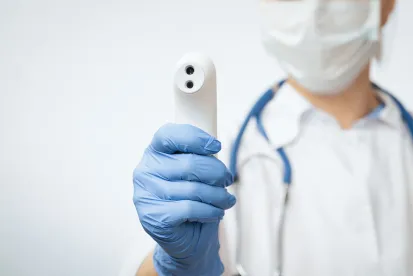Now that the U.S. Equal Employment Opportunity Commission (EEOC) acknowledges that employers may implement temperature screening measures in response to the current COVID-19 pandemic, many employers want to conduct them, and want to know how to conduct them. In some locations, employers may even feel compelled to conduct them based on location-specific or general community mitigation guidance from the U.S. Centers for Disease Control and Prevention (CDC). This guidance listed temperature checks as a potential mitigation activity for workplaces: “Consider regular health checks (e.g., temperature and respiratory symptom screening) of students, staff, and visitors entering buildings (if feasible),” or guidance from local public health authorities.
Unfortunately, the CDC and the Occupational Safety and Health Administration (OSHA) have not published guidance on the topic of how to conduct these health checks. On the CDC’s recent COVID-19 webinar, Dr. Nancy Messonnier, the CDC’s director of the center for the National Center for Immunization and Respiratory Diseases, responded to a temperature-screening question by pointing out that for a private company this would differ by company and to check with counsel. She then urged companies to require employees work from home as much as possible.
But the issue is not going away. Case numbers in the United States continue to rise while the COVID-19 pandemic is in its acceleration phase (and particularly as testing becomes more ubiquitous). In the wake of government shutdowns of nonessential businesses, those that remain open feel pressure to take some action, and temperature checks seems a natural choice after the EEOC guidance. Recently, a major newspaper ran a photograph on its front page of a White House medical checkpoint in which an unidentified temperature-taker is holding a thermometer to the head of a staff member returning from an errand. If the White House is implementing these measures, employers may ask, why shouldn’t they do the same?
Ohio Provides Guidance on Screening Employees
There is certainly a robust debate on the effectiveness of temperature screening, which we will not get into here. For now, many questions remain unanswered. What control measures should employers use at temperature checkpoints? What personal protective equipment (PPE) should the temperature-taker wear? Should workers standing in line space themselves six feet or more apart? What happens if the temperature-taker holds the thermometer too close to the worker, or presses it against the worker’s forehead? These questions require consultation with medical experts. Federal agencies like the CDC and OSHA are not (yet) providing answers to these questions.
But Ohio has made an attempt. On March 24, 2020, the Ohio Department of Health published “Screening Employees for COVID-19,” which states the following regarding taking employees’ temperatures:
-
“It is best to use touchless thermometers (forehead/temporal artery thermometers) if possible, but if you must use oral or other types of thermometers, make sure to clean the thermometers thoroughly between each employee, as to not spread infection.”
-
“Follow the manufacturer’s directions to disinfect the thermometer.”
-
“If no directions are available, rinse the tip of the thermometer in cold water, clean it with alcohol or alcohol swabs, and then rinse it again.”
-
“If you do not have thermometers on site, have your employees take their temperatures at home. They should stay home if they have a fever and follow the same protocol.”
-
“There is currently a shortage on thermometers. If you cannot find thermometers, and employees do not have one at home to check their temperature you can screen each incoming employee with a basic questionnaire.”
More Guidance Needed
But what if an employee gets sick and traces it to the temperature checks? The Ohio guidance does not appear to shield employers from liability if a temperature check ultimately results in employees or visitors contracting COVID-19.
Ohio’s guidelines do not address important questions such as who should conduct the check, what PPE they should wear, and what training they should have—and suggest that questionnaires are a reasonable alternative. For employers that do not want to wait on government guidance, perhaps the current best course of action is to retain a medical safety consultant, ideally a physician or epidemiologist, to help develop internal procedures and protocol. After this decision is made, employers may then want to consider employment law issues such as privacy, disclosure, and consequences of noncompliance.




 />i
/>i

